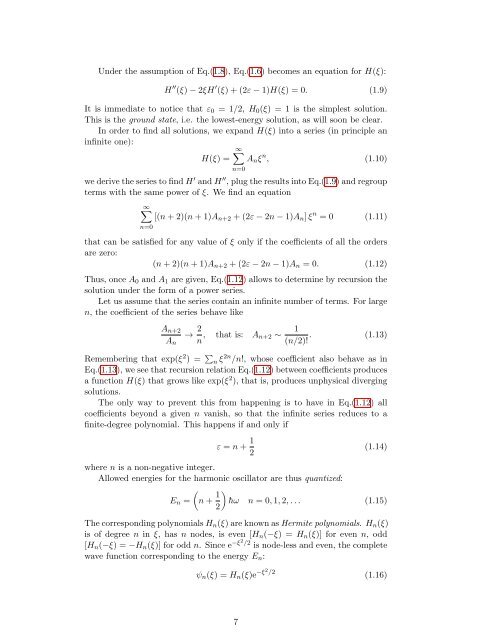Numerical Methods in Quantum Mechanics - Dipartimento di Fisica
Numerical Methods in Quantum Mechanics - Dipartimento di Fisica
Numerical Methods in Quantum Mechanics - Dipartimento di Fisica
Create successful ePaper yourself
Turn your PDF publications into a flip-book with our unique Google optimized e-Paper software.
Under the assumption of Eq.(1.8), Eq.(1.6) becomes an equation for H(ξ):<br />
H ′′ (ξ) − 2ξH ′ (ξ) + (2ε − 1)H(ξ) = 0. (1.9)<br />
It is imme<strong>di</strong>ate to notice that ε 0 = 1/2, H 0 (ξ) = 1 is the simplest solution.<br />
This is the ground state, i.e. the lowest-energy solution, as will soon be clear.<br />
In order to f<strong>in</strong>d all solutions, we expand H(ξ) <strong>in</strong>to a series (<strong>in</strong> pr<strong>in</strong>ciple an<br />
<strong>in</strong>f<strong>in</strong>ite one):<br />
∞∑<br />
H(ξ) = A n ξ n , (1.10)<br />
n=0<br />
we derive the series to f<strong>in</strong>d H ′ and H ′′ , plug the results <strong>in</strong>to Eq.(1.9) and regroup<br />
terms with the same power of ξ. We f<strong>in</strong>d an equation<br />
∞∑<br />
[(n + 2)(n + 1)A n+2 + (2ε − 2n − 1)A n ] ξ n = 0 (1.11)<br />
n=0<br />
that can be satisfied for any value of ξ only if the coefficients of all the orders<br />
are zero:<br />
(n + 2)(n + 1)A n+2 + (2ε − 2n − 1)A n = 0. (1.12)<br />
Thus, once A 0 and A 1 are given, Eq.(1.12) allows to determ<strong>in</strong>e by recursion the<br />
solution under the form of a power series.<br />
Let us assume that the series conta<strong>in</strong> an <strong>in</strong>f<strong>in</strong>ite number of terms. For large<br />
n, the coefficient of the series behave like<br />
A n+2<br />
A n<br />
→ 2 n , that is: A n+2 ∼ 1<br />
(n/2)! . (1.13)<br />
Remember<strong>in</strong>g that exp(ξ 2 ) = ∑ n ξ2n /n!, whose coefficient also behave as <strong>in</strong><br />
Eq.(1.13), we see that recursion relation Eq.(1.12) between coefficients produces<br />
a function H(ξ) that grows like exp(ξ 2 ), that is, produces unphysical <strong>di</strong>verg<strong>in</strong>g<br />
solutions.<br />
The only way to prevent this from happen<strong>in</strong>g is to have <strong>in</strong> Eq.(1.12) all<br />
coefficients beyond a given n vanish, so that the <strong>in</strong>f<strong>in</strong>ite series reduces to a<br />
f<strong>in</strong>ite-degree polynomial. This happens if and only if<br />
ε = n + 1 2<br />
(1.14)<br />
where n is a non-negative <strong>in</strong>teger.<br />
Allowed energies for the harmonic oscillator are thus quantized:<br />
(<br />
E n = n + 1 )<br />
¯hω n = 0, 1, 2, . . . (1.15)<br />
2<br />
The correspond<strong>in</strong>g polynomials H n (ξ) are known as Hermite polynomials. H n (ξ)<br />
is of degree n <strong>in</strong> ξ, has n nodes, is even [H n (−ξ) = H n (ξ)] for even n, odd<br />
[H n (−ξ) = −H n (ξ)] for odd n. S<strong>in</strong>ce e −ξ2 /2 is node-less and even, the complete<br />
wave function correspond<strong>in</strong>g to the energy E n :<br />
ψ n (ξ) = H n (ξ)e −ξ2 /2<br />
(1.16)<br />
7
















